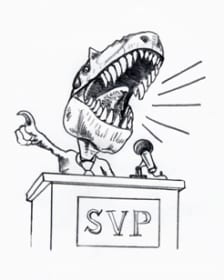
The Alfred Sherwood Romer Prize recognizes an outstanding scientific contribution in vertebrate paleontology by a predoctoral student. Selection of Romer Prize session participants is based on the scientific value and quality of a submitted abstract summarizing an original research project. The prize is awarded based on the scientific value and quality of the oral presentation of that research during the Romer Prize session at the SVP Annual Meeting.
ELIGIBILITY REQUIREMENTS
Current membership in SVP is required. If you have not joined or renewed your membership for the current calendar year, please do so before submitting your abstract.
- A predoctoral student is defined as a student in an undergraduate or graduate degree program who has not received a doctoral degree or has held a doctoral degree for less than one year at the time of the Annual Meeting.
- Previously published abstracts cannot be submitted.
- Only single-authored projects are considered.
- Past Romer Prize winners are not eligible to apply.
- The work is relevant to Vertebrate Paleontology with direct applications or relevance to understanding and interpreting the vertebrate fossil record, particularly for projects describing new methods developed from living organisms and/or actualistic studies.
- The work should address a question or a set of questions in a scientific fashion and provide results that have a robust scientific implication.
- The work should present a complete, comprehensive study including sufficient background and information on methods for the evaluation of the significance and suitability of the research and methods.
HOW TO APPLY
Abstracts may be submitted during the annual SVP abstract submission period via the online abstract submission platform (select the Romer Prize presentation category and select "Apply" for the Romer Prize in the Award Application section).
- The abstract submission process includes a series of questions to establish eligibility:
- the applicant's current degree program, estimated date of completion and institution.
- all undergraduate and graduate degrees previously awarded, degree dates and awarding institutions.
- the applicant’s current position and institution in the case of an applicant who already has a doctorate but that will be within one year of the degree date at the time of the Annual Meeting.
- The winner is selected from finalists onsite and announced at the Awards Banquet.
- Please note that any abstract that is not selected for the Romer Prize session will be moved to regular submission status.
ROMER PRIZE GUIDELINES
Based on the Romer Prize Charter, applicants should note that:
- Abstracts must be well written and meet the minimum quality standards set for all abstracts submitted for presentation at the SVP Annual Meeting.
- Abstracts, without exception, must meet all formatting requirements as set in the Oral Presentation Guidelines set by the SVP Program Committee. Understanding these guidelines is the responsibility of the applicant.
- Abstracts should clearly state the question(s) or problem(s) addressed, the importance or significance of the research, the methods used with sufficient explanation, and the basic results and implications or conclusions.
The Romer Prize Panel will judge the oral presentations during the Romer Prize session at the Annual Meeting and will award the Romer Prize based on the quality of the research, satisfaction of the general criteria for the Romer Prize as outlined in the charter of the Romer Prize, and the overall quality of the presentation itself. Presentations should provide sufficient information on background and methods for the Panel members and the audience to evaluate the relevance or importance of the questions examined and the basis and suitability of the methods and data used to address the questions. Presentations that are complete, comprehensive and utilize the time format properly (12 minutes for presentation and three minutes for questions or discussion) will fare better than those that try to review too many projects at the expense of comprehensiveness and clarity and/or do not leave time for questions or discussion or go over time. Students participating should note the emphasis placed by the Panel on the time format for the oral presentations.
The 2025 abstract submission deadline has now passed.
QUESTIONS?
Contact Dr. Susannah Maidment, Chair, Romer Prize Panel